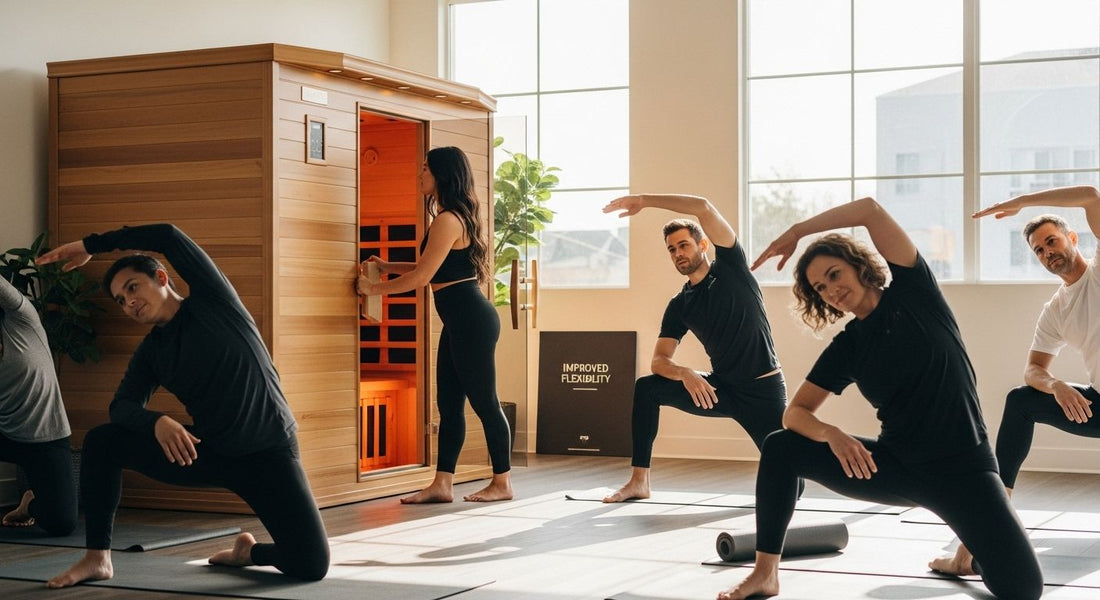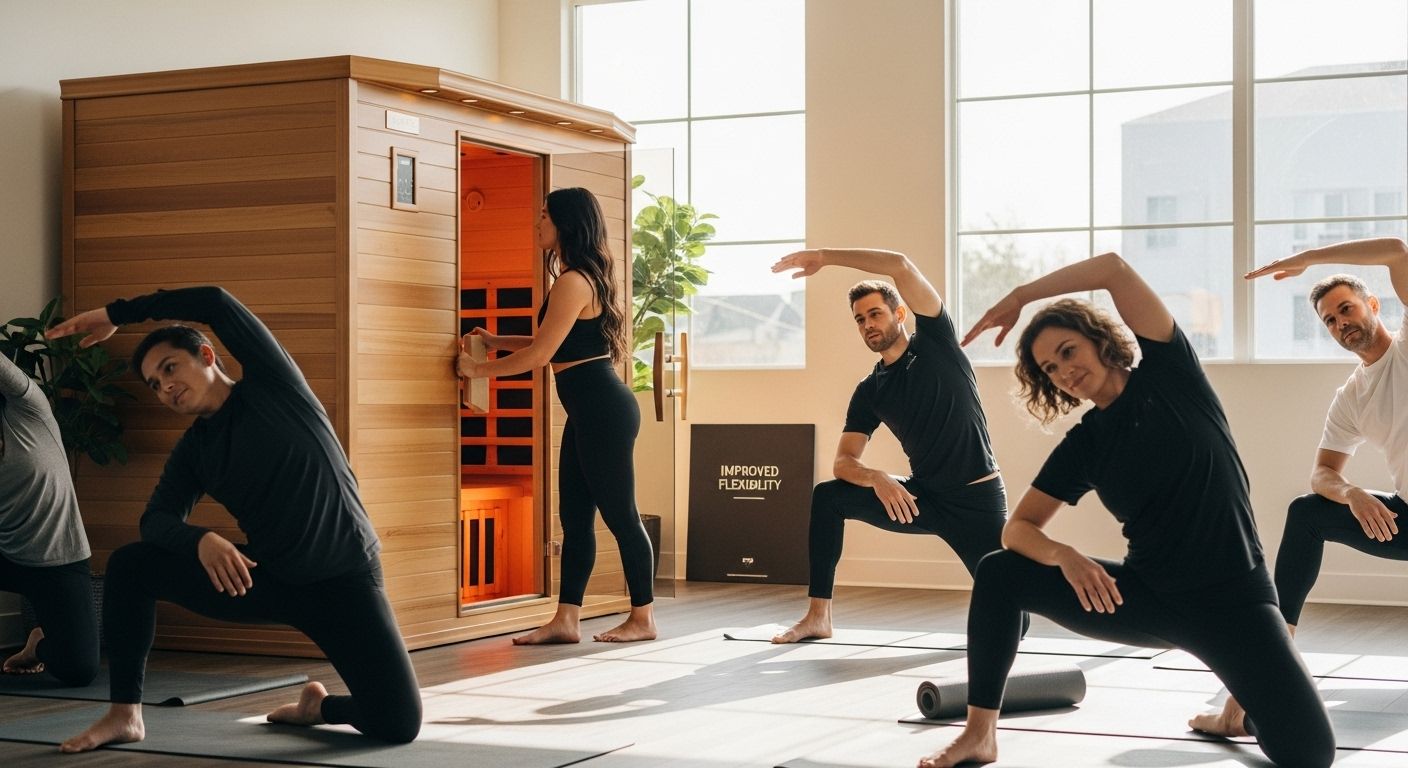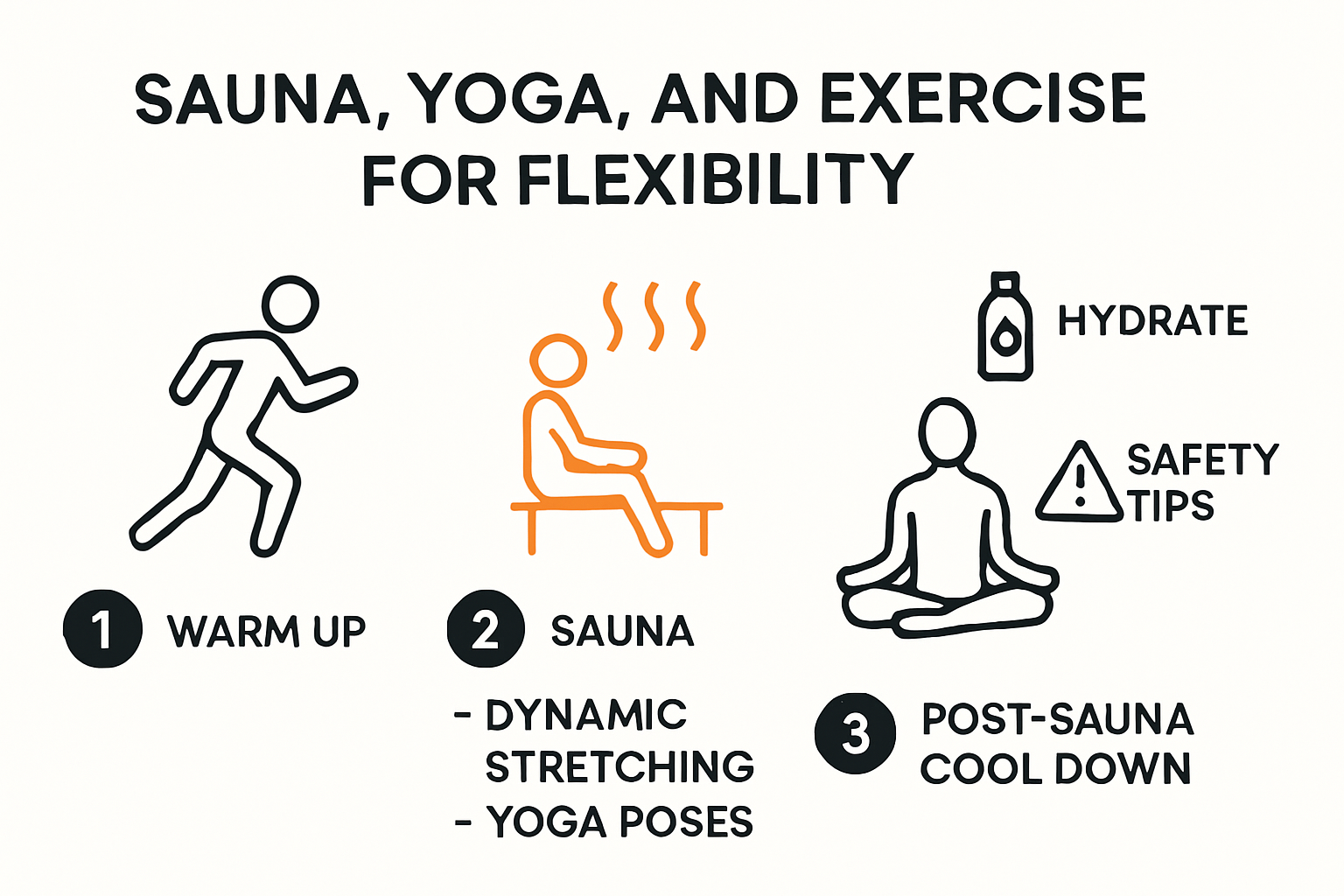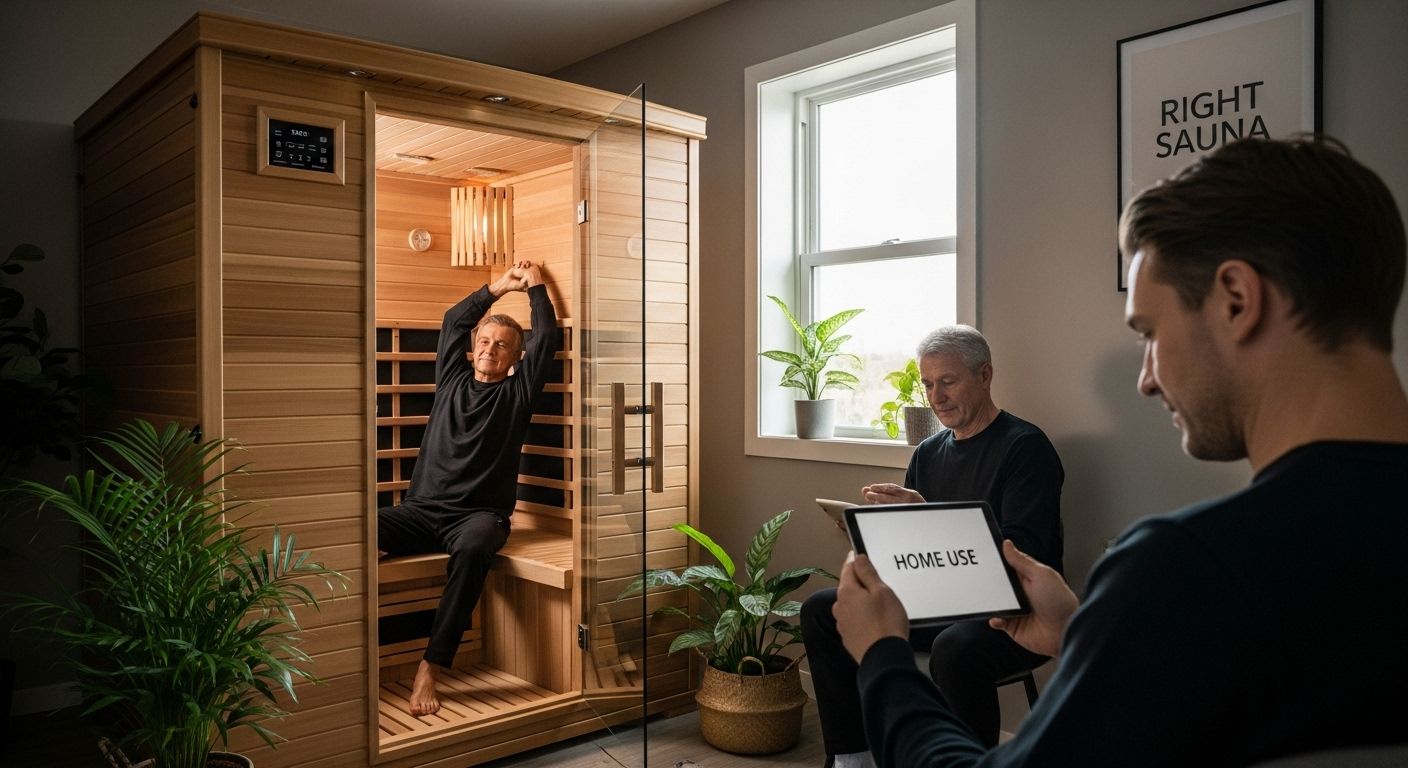
Sauna for Improved Flexibility: Easy Ways to Boost in 2025

People chase flexibility with endless stretching routines and yoga classes, but what if there was a shortcut hiding in plain sight? Recent studies show stretching in an infrared sauna can boost flexibility by a jaw-dropping 205 percent compared to a regular gym session. It sounds almost too good to be true. Most folks overlook the power of heat on muscles entirely, yet this simple tweak could unlock levels of mobility they never thought possible.
Table of Contents
- How Saunas Help Enhance Flexibility
- Best Sauna Routines For Stretching
- Combining Sauna With Yoga Or Exercise
- Choosing The Right Sauna For Home Use
Quick Summary
| Takeaway | Explanation |
|---|---|
| Sauna heat improves muscle flexibility | Exposure to sauna heat enhances muscle pliability, reducing tension and promoting deeper stretches. |
| Incorporate dynamic and targeted stretches | Start with dynamic movements to warm up, then focus on major muscle groups for effective flexibility gains. |
| Stay hydrated during sauna sessions | Maintain hydration levels to prevent overheating and support muscle recovery during and after sauna use. |
| Combine sauna with yoga for flexibility | Practicing yoga in a sauna increases flexibility and helps muscles relax, enabling deeper stretches. |
| Consider sauna type and installation needs | Evaluate different sauna types and installation factors to choose one that suits your wellness goals and space. |
How Saunas Help Enhance Flexibility
Flexibility is a crucial component of overall physical fitness and wellness, and saunas offer a surprising method to improve muscle elasticity and joint mobility. The heat-based environment of saunas creates unique physiological responses that directly contribute to enhanced flexibility.
The Science Behind Heat and Muscle Relaxation
When your body is exposed to the intense heat of a sauna, several remarkable physiological changes occur that support muscle flexibility. Research published in the International Journal of Environmental Research and Public Health revealed that heat exposure can significantly improve range of motion and muscle extensibility. The elevated temperatures cause muscles to relax and become more pliable, reducing tension and increasing the potential for deeper stretches.
The thermal environment triggers a cascade of responses in your body. Blood vessels dilate, increasing circulation and delivering more oxygen to muscle tissues. This enhanced blood flow helps reduce muscle stiffness and promotes greater elasticity. Additionally, the heat stimulates the production of heat shock proteins, which help protect and repair muscle fibers, potentially reducing the risk of injury during flexibility exercises.
Neurological and Muscular Benefits of Sauna Flexibility Training
A comprehensive review in the Journal of Exercise Rehabilitation highlighted the neurological benefits of heat exposure on muscle function. The sauna environment can help recalibrate the nervous system’s response to muscle tension, essentially resetting muscle memory and promoting more effective movement patterns. This neurological adaptation means that regular sauna sessions could potentially improve your body’s inherent flexibility over time.
Interestingly, the heat-induced cardiovascular changes are similar to those experienced during moderate exercise. Your heart rate increases, and peripheral blood flow improves, creating an environment that supports muscle relaxation and enhanced joint mobility. For individuals struggling with chronic muscle tension or limited range of motion, sauna sessions might offer a gentle yet effective approach to improving overall flexibility.
Therapeutic Applications for Flexibility
A systematic review in Evidence-Based Complementary and Alternative Medicine explored the clinical implications of sauna therapy for individuals with mobility challenges. The research indicated that patients with conditions like rheumatoid arthritis experienced temporary reductions in joint stiffness and improved flexibility during sauna treatments. While the effects were not permanent, these findings suggest potential therapeutic applications for individuals seeking natural methods to enhance muscle and joint mobility.
To maximize flexibility benefits, consider incorporating gentle stretching within the sauna environment. The warm temperatures will help prepare your muscles, making stretches more effective and reducing the risk of strain. Start with light, controlled movements and gradually increase your range of motion as your body adapts to the heat.
Remember that individual responses to sauna therapy can vary. Always listen to your body, stay hydrated, and consult with a healthcare professional if you have pre-existing medical conditions or concerns about heat exposure. Consistency is key when using saunas to improve flexibility, so aim for regular, moderate sessions to experience the most significant benefits.
Best Sauna Routines for Stretching
Designing an effective stretching routine within the sauna requires strategic planning and understanding of how heat impacts muscle flexibility. By combining targeted stretches with the therapeutic warmth of a sauna, you can dramatically improve your overall mobility and physical performance.
Dynamic Stretching Techniques
Research from Auburn University Montgomery revealed that stretching in a far infrared sauna can improve flexibility by an astounding 205% compared to traditional gym environments. This extraordinary result suggests that dynamic stretching routines are particularly effective when performed in heated environments.
Begin your sauna stretching routine with gentle dynamic movements. Start with arm circles, torso twists, and leg swings that engage multiple muscle groups simultaneously. These movements help warm up your muscles, increase blood circulation, and prepare your body for more intensive stretches. Focus on smooth, controlled motions that do not cause strain or discomfort. Aim to spend approximately 5-7 minutes performing these dynamic stretches to gradually elevate your muscle temperature and enhance overall flexibility.
Targeted Flexibility Protocols
A comprehensive study published in the International Journal of Environmental Research and Public Health demonstrated remarkable improvements in flexibility through structured heat-based interventions. Participants who engaged in systematic stretching protocols experienced significant gains in range of motion.
Implement a targeted stretching sequence that addresses major muscle groups. Focus on key areas such as hamstrings, quadriceps, hip flexors, shoulders, and lower back. Hold each stretch for 20-30 seconds, breathing deeply and maintaining a relaxed posture. Consider incorporating yoga-inspired poses like forward folds, lunges, and gentle twists. The sauna’s heat will help muscles relax, allowing for deeper and more comfortable stretches. Remember to move slowly and mindfully, listening to your body’s signals and avoiding overexertion.
Safety and Progressive Flexibility Training
While the benefits of sauna stretching are significant, proper precautions are essential. Evidence from clinical research suggests that progressive, controlled flexibility training yields the most sustainable results. Start with shorter sauna sessions of 10-15 minutes and gradually increase duration as your body adapts.
Stay hydrated before, during, and after your sauna stretching routine. Bring a water bottle and take small sips to replace fluids lost through perspiration. Wear lightweight, breathable clothing that allows for unrestricted movement. If you experience dizziness, excessive fatigue, or discomfort, exit the sauna immediately and cool down.
Pro tips for maximizing your sauna stretching routine include:
- Timing: Perform stretches during the middle of your sauna session when muscles are most relaxed
- Breathing: Practice deep, controlled breathing to enhance relaxation and flexibility
- Progression: Slowly increase stretch duration and complexity as your flexibility improves
Consult with a fitness professional or healthcare provider to develop a personalized sauna stretching plan that aligns with your specific fitness goals and physical condition. By approaching sauna stretching systematically and mindfully, you can unlock new levels of flexibility and overall physical wellness.
To help you plan and structure your sauna-based flexibility training, here’s a table summarizing a recommended sauna stretching routine process based on steps mentioned in the article:
| Step | Description | Duration/Tips |
|---|---|---|
| Dynamic Warmup | Begin with arm circles, torso twists, leg swings | 5–7 minutes; engage major muscles |
| Targeted Stretch | Focus on hamstrings, quads, hips, shoulders, back | Hold each stretch for 20–30 sec |
| Yoga-Inspired Moves | Include forward folds, lunges, gentle twists | Controlled, deep breathing |
| Safety Checks | Monitor for discomfort/fatigue, stay hydrated | Exit if dizzy, sip water |
| Progression | Gradually increase duration/complexity | Consult pro as needed |
Combining Sauna With Yoga or Exercise
Integrating sauna sessions with yoga and exercise can create a powerful synergy that amplifies physical performance, flexibility, and overall wellness. By strategically combining these practices, individuals can unlock enhanced physiological benefits and optimize their fitness routines.

Sauna Yoga: A Holistic Approach to Fitness
Research published in scientific journals demonstrated remarkable improvements in flexibility through sauna yoga practices. A randomized controlled trial revealed an astounding 83% increase in flexibility among participants who practiced yoga in heated environments. This significant finding suggests that the combination of heat and mindful movement can dramatically transform physical capabilities.
When practicing yoga in a sauna, focus on gentle, controlled movements that leverage the heat’s muscle-relaxing properties. Begin with foundational poses like mountain pose, gentle twists, and seated forward folds. The elevated temperature helps muscles become more pliable, allowing for deeper stretches and reduced risk of injury. Maintain slow, deliberate breathing to help manage the heat and enhance mind-body connection. Aim for sessions lasting 15-20 minutes, paying close attention to your body’s response and hydration levels.
Exercise Performance and Sauna Integration
A comprehensive study examining hot yoga practices highlighted significant improvements in energy expenditure and range of motion when exercise is performed in heated environments. The research indicates that heat exposure can enhance metabolic processes and improve overall physical performance.
Consider implementing a structured approach to combining exercise and sauna sessions. Start with a brief warm-up in the sauna to increase muscle temperature and improve flexibility. Follow this with low-intensity exercises like bodyweight movements, resistance band work, or light strength training. The pre-heated muscles will be more responsive and less prone to strain. After your workout, return to the sauna for a recovery session that promotes muscle relaxation and supports faster recovery.
Advanced Recovery and Performance Strategies
A meta-analysis exploring physical fitness interventions demonstrated the comprehensive benefits of heat-based training methods. The research emphasized the potential for improved muscle strength, balance, and overall mobility when incorporating heat-based practices into fitness routines.
To maximize benefits, develop a periodized approach to sauna and exercise integration. Create a schedule that allows for progressive adaptation. Start with shorter, less intense sessions and gradually increase duration and complexity. Key considerations include:
- Hydration: Drink water before, during, and after combined sauna and exercise sessions
- Duration: Begin with 10-15 minute sauna sessions and slowly extend time
- Intensity: Monitor your body’s response and adjust workout intensity accordingly
Professional athletes and fitness enthusiasts can benefit from this integrated approach. The combination of sauna, yoga, and exercise creates a comprehensive training method that addresses flexibility, strength, recovery, and mental focus. Always consult with a healthcare professional or certified fitness trainer to develop a personalized plan that matches your individual fitness goals and physical condition.
Remember that individual responses to heat and exercise vary. Listen to your body, stay hydrated, and prioritize safety while exploring these innovative fitness strategies. The key is consistent, mindful practice that respects your body’s unique capabilities and limitations.
Choosing the Right Sauna for Home Use
Selecting the perfect sauna for your home involves careful consideration of multiple factors, including available space, personal health goals, budget, and specific wellness requirements. Understanding the nuanced differences between sauna types can help you make an informed decision that enhances your flexibility and overall wellness journey.
Sauna Types and Construction Materials
Research from DesignHorizons highlights the importance of construction materials in sauna selection. Traditional saunas often utilize Nordic spruce or cedar, materials known for their natural resistance to moisture and excellent thermal properties. These woods not only provide aesthetic appeal but also contribute to the sauna’s overall performance and durability.
Two primary sauna categories dominate the home market: traditional electric saunas and infrared saunas. Traditional saunas heat the air around you, creating a high-temperature environment that induces intense sweating. Infrared saunas, by contrast, use electromagnetic radiation to directly warm your body, operating at lower ambient temperatures while providing deep tissue heating. The choice between these types depends on your personal comfort preferences, health objectives, and sensitivity to heat.
Here is a comparison table to help you quickly evaluate the differences between traditional saunas and infrared saunas for home use, as described in the article:
| Feature/Aspect | Traditional Sauna | Infrared Sauna |
|---|---|---|
| Heating Method | Heats the air around you | Directly heats the body with infrared |
| Temperature Range | High (more intense heat) | Lower ambient temperatures |
| Construction Materials | Nordic spruce, cedar | Similar or varied materials |
| Sweat Intensity | Greater | Less, but deep tissue heating |
| Ideal For | Those seeking intense heat benefits | Those sensitive to heat/lesser heat |
| Typical Cost Range | $5,000–$25,000 (custom builds possible) | $1,000+ (entry-level/portable units) |
| Key Benefits | Intense sweating, cardiovascular/flex | Deep tissue heat, gentle flexibility |
Space and Installation Considerations
Lowe’s comprehensive sauna guide emphasizes the critical factors of space and installation when selecting a home sauna. Consider the following key aspects:
- Indoor vs Outdoor: Determine whether you want a portable unit, a built-in room, or an outdoor standalone structure
- Electrical Requirements: Ensure your home’s electrical system can support the sauna’s power needs
- Size and Capacity: Select a sauna that comfortably accommodates your body and potential future usage
Health and Performance Evaluation
Scioto Valley’s expert guide provides insights into matching sauna types with individual health goals. Infrared saunas might be preferable for individuals seeking lower-temperature experiences or those with heat sensitivity. Traditional saunas offer more intense heat exposure, potentially providing more pronounced cardiovascular and flexibility benefits.
When evaluating performance, consider these crucial factors:
- Heating Technology: Compare wattage, heat distribution, and warm-up times
- Temperature Range: Ensure the sauna offers adjustable settings
- Additional Features: Look for chromotherapy lighting, bluetooth speakers, or digital controls
Budget plays a significant role in your selection. Entry-level portable infrared saunas can start around $1,000, while custom-built traditional saunas might cost $5,000 to $25,000. Consider long-term value, energy efficiency, and potential health benefits when making your investment.
Prioritize professional consultation before final purchase. A healthcare provider can offer personalized recommendations based on your specific health conditions, flexibility goals, and physical capabilities. Many manufacturers also provide consultation services to help you select the most suitable sauna for your unique needs.

Remember that a home sauna is more than just a purchase it is an investment in your personal wellness journey. Take time to research, test different models if possible, and choose a sauna that aligns with your long-term health and flexibility objectives.
Frequently Asked Questions
How does sauna use improve flexibility?
Exposure to the heat of a sauna enhances muscle pliability and reduces tension, allowing for deeper and more effective stretching. This process can significantly improve the range of motion in joints.
What types of saunas are best for improving flexibility?
Both traditional electric saunas and infrared saunas can aid flexibility. Traditional saunas provide intense heat through heated air, while infrared saunas directly warm the body at lower temperatures. The choice depends on personal comfort and heat sensitivity.
How should I structure my sauna stretching routine?
A typical sauna stretching routine includes starting with dynamic warm-up movements for 5-7 minutes, followed by targeted stretches for major muscle groups, and incorporating yoga-inspired poses while ensuring mindful breathing.
What precautions should I take when using a sauna for flexibility training?
Stay hydrated before, during, and after sauna sessions. Start with shorter sessions to allow your body to adjust, and monitor for any discomfort or dizziness. Always consult a healthcare professional if you have pre-existing conditions.
Experience True Flexibility Gains With Best Life Sauna
Struggling to unlock deeper flexibility or frustrated with static stretches that never seem to help? You just discovered how sauna heat can dramatically enhance muscle pliability and supercharge your stretching results. Now imagine experiencing those remarkable gains in the comfort of your own home. At Best Life Sauna, you will find expertly designed options ranging from modern infrared saunas to luxurious traditional setups. Each one is created to help you safely enjoy the full benefits outlined in this article, including improved range of motion, faster recovery, and profound overall wellness.

Ready to put the science into practice and finally move beyond fitness plateaus? Browse our selection at Best Life Sauna to discover wellness solutions with exclusive perks like our price match guarantee and free shipping on qualifying orders. Make this the year you take control of your flexibility journey. Start today and feel the difference every session makes.

